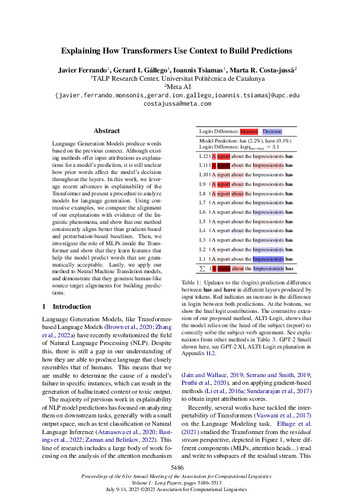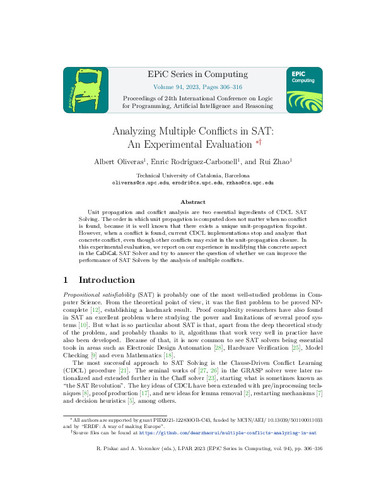Ponències/Comunicacions de congressos
Enviaments recents
-
Padding Aware Neurons

(Institute of Electrical and Electronics Engineers (IEEE), 2023)
(Institute of Electrical and Electronics Engineers (IEEE), 2023)
Text en actes de congrés
Accés obertConvolutional layers are a fundamental component of most image-related models. These layers often implement by default a static padding policy (e.g. zero padding), to control the scale of the internal representations, and ... -
Analyzing text representations by measuring task alignment

(Association for Computational Linguistics, 2023)
(Association for Computational Linguistics, 2023)
Text en actes de congrés
Accés obertTextual representations based on pre-trained language models are key, especially in few-shot learning scenarios. What makes a representation good for text classification? Is it due to the geometric properties of the space ... -
Applying generative models and transfer learning to physiological data classification

(IOS Press, 2023-11-01)
(IOS Press, 2023-11-01)
Text en actes de congrés
Accés obertThe scarcity and imbalance of datasets for training deep learning models in a specific task is a common problem. This is especially true in the physiological domain where many applications use complex data collection ... -
Brealing through the traffic congestion: asynchronous time series data integration and XGBoost for accurate traffic density prediction

(Institute of Electrical and Electronics Engineers (IEEE), 2023)
(Institute of Electrical and Electronics Engineers (IEEE), 2023)
Text en actes de congrés
Accés obert -
Measuring the mixing of contextual information in the transformer

(Association for Computational Linguistics, 2022)
(Association for Computational Linguistics, 2022)
Comunicació de congrés
Accés obertThe Transformer architecture aggregates input information through the self-attention mechanism, but there is no clear understanding of how this information is mixed across the entire model. Additionally, recent works have ... -
Explaining how transformers use context to build predictions

(Association for Computational Linguistics, 2023)
(Association for Computational Linguistics, 2023)
Comunicació de congrés
Accés obertLanguage Generation Models produce words based on the previous context. Although existing methods offer input attributions as explanations for a model’s prediction, it is still unclear how prior words affect the model’s ... -
Ensemble model-based method for time series sensors’ data validation and imputation applied to a real waste water treatment plant

(International Environmental Modelling and Software Society (iEMSS), 2022)
(International Environmental Modelling and Software Society (iEMSS), 2022)
Comunicació de congrés
Accés obertIntelligent Decision Support Systems (IDSSs) integrate different Artificial Intelligence (AI) techniques with the aim of taking or supporting human-like decisions. To this end, these techniques are based on the available ... -
Recognition of conformational states of a G protein coupled receptor from molecular dynamic simulations using sampling techniques

(Springer, 2023)
(Springer, 2023)
Text en actes de congrés
Accés restringit per política de l'editorialProtein structures are complex and dynamic entities relevant to many biological processes. G-protein-coupled receptors in particular are a functionally relevant family of cell membrane proteins of interest as targets in ... -
Translate first reorder later: leveraging monotonicity in semantic parsing

(Association for Computational Linguistics, 2023)
(Association for Computational Linguistics, 2023)
Text en actes de congrés
Accés obertPrior work in semantic parsing has shown that conventional seq2seq models fail at compositional generalization tasks. This limitation led to a resurgence of methods that model alignments between sentences and their ... -
Adding preferences and moral values in an agent-based simulation framework for high-performance computing

(2023)
(2023)
Text en actes de congrés
Accés obertAgent-Based Simulation is a suitable approach used now-a-days to simulate and analyze complex societal environments and scenarios. Current Agent-Based Simulation frameworks either scale quite well in computation but implement ... -
Explainable agents adapt to human behaviour

(2023)
(2023)
Text en actes de congrés
Accés obertWhen integrating artificial agents into physical or digital environments that are shared with humans, agents are often equipped with opaque Machine Learning methods to enable adapting their behaviour to dynamic human needs ... -
Analyzing multiple conflicts in SAT: an experimental evaluation

(EasyChair Publications, 2023)
(EasyChair Publications, 2023)
Text en actes de congrés
Accés obertUnit propagation and conflict analysis are two essential ingredients of CDCL SAT Solving. The order in which unit propagation is computed does not matter when no conflict is found, because it is well known that there exists ...












